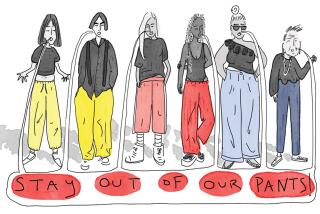When clothes are a costar: ‘Sisterhood’s’ predecessors
- Share via
“The Sisterhood of the Traveling Pants,” opening Wednesday, follows a pivotal summer in the lives of four teenagers. For the first time ever, lifelong friends Carmen, Bridget, Lena and Tibby will be spending the summer apart.
When they find a pair of thrift-shop blue jeans that magically fits all four of their body shapes, the girls decide to use the pants as a way of keeping in touch. Each girl will wear the pants for a week to see if they bring luck, and then send them off to the next.
Though it’s rare that a piece of clothing plays a pivotal part in a movie -- let alone be part of the title -- apparel has played an important role over the years.
Take the 1927 Frank Capra silent comedy classic “Long Pants.” Harry Langdon plays a man-child who has been kept in knee pants well into adulthood by his overprotective parents. When he finally gets his first pair of long pants, the shy young man turns into a womanizer and nearly loses his childhood sweetheart.
In 1950’s “Fancy Pants,” Bob Hope plays a hack American actor toiling in England in a play in which he portrays an English butler -- only to be mistaken for a real-life butler by a nouveau riche American woman. She hires him to come to New Mexico to teach her headstrong daughter (Lucille Ball) manners.
A tuxedo tailcoat is the focus of the all-star 1942 anthology “Tales of Manhattan.” The comedy-drama follows the exploits of the tailcoat as it passes through the hands of various New Yorkers including Charles Boyer as an actor who is having a torrid affair; Charles Laughton as an orchestra conductor; and Edward G. Robinson as a bum who wears the tailcoat to his college reunion.
One of Alec Guinness’ best comedies was 1951’s “The Man in the White Suit,” directed by Alexander Mackendrick. Guinness plays a nebbish inventor named Sidney Stratton, who causes uproar when he invents a fabric that won’t get dirty.
And Gregory Peck gives a well-tailored performance as “The Man in the Gray Flannel Suit,” the glossy 1956 adaptation of Sloan Wilson’s seminal novel about the post-World War II American executive.
-- Susan King
More to Read
Only good movies
Get the Indie Focus newsletter, Mark Olsen's weekly guide to the world of cinema.
You may occasionally receive promotional content from the Los Angeles Times.











